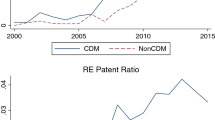Abstract
The paper deals with the diffusion of GHG mitigation technologies in developing countries. We develop a model where an abatement technology is progressively adopted by firms and we use it to compare the Clean Development Mechanism (CDM) with a standard Cap and Trade scheme (C&T). In the presence of learning spillovers, we show that the CDM yields a higher social welfare than C&T if the first adopter receives CDM credits whereas the followers do not. The analysis leads us to suggest two CDM design improvements: relaxing the additionality constraint for projects which generate significant learning externalities, and allowing collective CDM projects which could internalize learning externalities.
Similar content being viewed by others
References
Baron R, Ellis J (2006) Sectoral crediting mechanisms for greenhouse gas mitigation: institutional and operational issues. OECD/IEA Information Paper COM/ENV/EPOC/IEA/SLT(2006)4
Blackman A (1999) The economics of technology diffusion: implications for climate policy in developing countries. Discussion Paper 99-42. Resources For the Future, Washington DC
Dechezleprêtre A, Glachant M, Ménière Y (2008) The clean development mechanism and the international diffusion of technologies: an empirical study. Energy Policy 36(4): 1273–1283
Fischer C, Parry I, Pizer W (2003) Instrument choice for environmental protection when technological innovation is endogenous. J Environ Econ Manag 45(3): 523–545
Fudenberg D, Tirole J (1985) Preemption and rent equalization in the diffusion of new technology. Rev Econ Stud 52: 383–401
Golombek R, Hoel M (2005) Climate policy under technology spillovers. Environ Resour Econ 31(2): 201–227
Greiner S, Michaelowa A (2003) Defining investment additionality for CDM projects—practical approaches. Energy Policy 31(10): 1007–1015
Hoppe (2002) The timing of new technology adoption: theoretical models and empirical evidence. Manchester School 70(1): 56–76
Jaffe A, Stavins R (1995) Dynamic incentives of environmental regulations: the effects of alternative policy instruments on technology diffusion. J Environ Econ Manag 29(3): S43–S63
Laffont J-J, Tirole J (1996) Pollution permits and environmental innovation. J Public Econ 62(1–2): 127–140
Liski M, Tahvonen O (2004) Can carbon tax eat OPEC’s rents?. J Environ Econ Manag 47(1): 1–12
Michaelowa A, Stronzik M, Eckermann F, Hunt A (2003) Transaction costs of the kyoto mechanisms. Clim Policy 3
Milliman S, Prince R (1989) Firm incentives to promote technological change in pollution control. J Environ Econ Manag 17(3): 247–265
Millock K (2002) Technology transfers in the Clean Development Mechanism: an incentive issue. Environ Dev Econ 7
Montero J-P (2002) Permits, standards, and technology innovation. J Environ Econ Manag 44(1): 23–44
Reinganum J (1981) Market structure and the diffusion of new technology. Bell J Econ 12: 618–624
Requate T (1998) Incentives to innovate under emission taxes and tradeable permits. Eur J Polit Econ 14(1): 139–165
Schneider M, Holzer A, Hoffmann V (2008) Understanding the CDM’s contribution to technology transfer. Energy Policy 36(8): 2930–2938
Author information
Authors and Affiliations
Corresponding author
Rights and permissions
About this article
Cite this article
Glachant, M., Ménière, Y. Project Mechanisms and Technology Diffusion in Climate Policy. Environ Resource Econ 49, 405–423 (2011). https://doi.org/10.1007/s10640-010-9439-5
Accepted:
Published:
Issue Date:
DOI: https://doi.org/10.1007/s10640-010-9439-5




